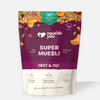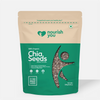
5 Vegan Foods Higher in Protein Than Meat (2024)
Have you ever googled high-protein foods, only to find meat, meat, and more meat?
And if it’s a vegan or vegetarian list, you will consistently find only beans and vegetables listed, which doesn't accurately represent the range of high-quality protein sources available on a plant-based diet.
To the average person, it would seem that vegans and vegetarians struggle to get any protein. In fact, getting enough protein is one of the most common concerns for anyone on a plant-based diet. But this couldn't be further from the truth.
That's because there are several plant-based foods which contain double, even triple the amount of protein in meat. Yup.
A protein-rich diet has numerous health benefits, such as muscle building, weight loss, and satiety after meals. While it’s not necessary to eat a high-protein diet, it’s vital for active individuals, especially those who lift heavy weights. That’s because protein is essential for bodily functions, forming cells and preserving/building muscle mass.
According to the Mayo Clinic, the recommended dietary allowance for a sedentary adult is 0.8 grams of protein per kilogram of body weight. If you’re active, it’s more.
To increase muscle mass, the American College of Sports Medicine recommends getting between 1.2-1.7 grams of protein per kilogram of body weight per day. This would apply to anyone who lifts weights regularly, trains, cycles, runs, and so on.
So, how can someone on a plant-based diet meet these needs? We’re here to showcase the top plant-based sources of protein available.
10 high sources of plant-based protein
1. Vital wheat gluten
We’re starting strong with vital wheat gluten. Vital wheat gluten is basically pure gluten without the starch. It's not exactly flour, but it's made from wheat flour. First, the wheat flour gets wet to activate the gluten, then the gluten is separated from the starch. After that, it's dried and ground into an extremely high-protein powder.
100g of vital wheat gluten contains 75g of protein (source: USDA).
You can make vegan sausage, vegan burger patties, bread, and so on.
You can't find vital wheat gluten in most stores in India, but it's cheap and can be bought for less than 1 rupee per gram of protein on Amazon. You can purchase it here.

2. Spirulina
Spirulina powder is made from blue-green algae. Not only is it very high in protein, it is also a rich source of vitamins and minerals. Consumers enjoy adding it to smoothies or juices for an extra nutritional boost. But beware, this isn’t the tastiest protein on the list.
100g of spirulina contains 66.7g of protein (source: USDA). You can purchase it here.

3. Nutritional yeast
Nutritional yeast is a type of yeast that's grown on molasses. It has a cheesy taste and is chock-full of vitamins, especially B vitamins. Consumers either love it or hate it.
100g of nutritional yeast contains 60g of protein (source: USDA).
Make vegan mac and cheese, use it to sprinkle over pizza or popcorn, add it to broths for seasoning, make bread, salad dressings, and so on. You can purchase it here.

4. Peanut butter powder
Peanut butter powder is exactly what it sounds like: roasted peanuts grinded into a fine powder. But what you might not know is that it's made by pressing the peanuts to remove most of the oil and fat. And since it's not fresh peanut butter, it's free from all that extra sugar and salt that often comes with peanut butter. What's left is a very high-protein, high-fibre food.
100g of peanut butter powder contains 54g of protein (source: MYPB). You can purchase it here.
All you need to do is combine the peanut butter powder with a small amount of water to make peanut butter. Enjoy it with peanut butter sandwiches, peanut chutney, breakfast bowls, throw into smoothies, or just combine with water to scoop it into your mouth!

5. Soya chunks
Soya chunks, unlike the other protein sources so far, are very easy to find for most Indians. And you guessed it - they’re high in protein!
100g of soya chunks contains 52g of protein (source: Nutrela Health).
Make vegan mutton curry, vegan ground beef, burger patties, parathas, stir-fries, fried rice, biryani, and so on.

6. Green dal & edamame spaghetti noodles
Wheat-based pasta is absolutely delicious - but relatively low in protein compared to other pasta varities.
100g of green dal & edamame spaghetti noodles contains 51g of protein.
Order here to make a high-protein aglio e olio for dinner!
7. Soybeans
Soybeans are incredible because they're inexpensive and very high in protein.
100g of soybeans contains 36.5g of protein.
Use them to make hummus, dry curries, or roast them for a crunchy, high-protein snack!
8. Sprouted watermelon seeds
Watermelon seeds are healthy, tasty, and inexpensive to get. You can eat them raw, roasted, or sprouted - and we say that sprouted is the best option.
100g of sprouted watermelon seeds contain 35.71g of protein (source: USDA).
9. Hulled hemp seeds
Hulled hemp seeds are the edible inner part of the hemp seed with the outer shell removed. They're small, soft, and have a mild, nutty flavour. They are rich in healthy fats, as well as essential vitamins and minerals.
100g of hulled hemp seeds contain 31.6g of protein (source: USDA).
Sprinkle them over salads, toasts, pizza, blend into a smoothie, make pesto with it, roast them, and so on. You can purchase them here.

10. Pumpkin seeds
Pumpkin seeds are easy to find and easy to love in laddoos, chutney, pesto, granola, desserts, and more.
100g of pumpkin seeds contains 29.84g of protein (source: USDA).

11. Sprouted chickpeas
We all know and love sprouted beans. They’re especially common in Indian cuisine, as they go perfectly in sambhars, chaats, curries, and more. But did you know that sprouted chickpeas are particularly high in protein?
100g of sprouted chickpeas contains 25.71g of protein (source: USDA).
For comparison, 100g of non-sprouted chickpeas contains 8.86g of protein (source: USDA). And not only does the protein explode, but so does the iron, fibre, potassium, and phosphorus. It’s extremely nutrient-dense after sprouting.

12. Split pea
Split pea is a dried pea that has been split along its natural seam, resulting in two symmetrical halves. They come from the same plant as whole peas, but they drying and splitting process makes them easier to cook and digest.
While not typically common in Indian cuisine, it can be used in curries, soups, rice dishes, and more.
100g of split pea contains 25g of protein (source: USDA).

13. Chickpea pasta
Chickpea pasta is a gluten-free version of wheat-based pasta. It’s delicious and can be used in exactly the same way as any regular pasta - plus it cooks just the same.
100g of chickpea pasta contains 24.56g of protein (source: USDA).
You can purchase it here.

And there you have it, 10 high-protein plant-based foods. Tofu didn’t even make the list! Can you believe it?
For comparison, consider this: 100g of cooked chicken contains 31g of protein, while 100g of cooked ground beef offers 25.54g of protein (source: USDA).
Surprisingly, vital wheat gluten boasts OVER double the protein content of ground beef by weight. Quite the revelation, isn't it?
Tips to add more protein into your diet
Maximising the protein from plants often involves processing, but not in the chemical-laden sense. Processing can include everyday methods, such as:
- Drying
- Blending
- Mashing
- Sprouting
- Cooking
- Fermentation
Processing doesn’t just improve nutrition, it also enhances flavour and texture. Take hummus, for example – far more appealing than plain boiled chickpeas, wouldn't you agree?
Another way to boost protein intake on a plant-based diet is to combine foods. Consider spirulina, a nutritional powerhouse that's not always easy to consume in large quantities. However, blending just one tablespoon of spirulina (providing 4g of protein) with fruits and high-protein vegan milk, such as soy milk, creates a delicious and protein-packed breakfast smoothie.
Here’s some other high-protein food combos:
- Sprouted chickpea hummus + whole wheat pita
- Moong dal + whole wheat chapatis
- Peanut butter powder + whole grain bread
- Seitan + nutritional yeast gravy
- Split pea soup + whole grain bread
- Hulled hemp seeds + soy milk
The last tip is to make informed decisions about your food choices.
When craving pasta, opt for chickpea pasta; when preparing dal, use moong dal. Instead of maida, use whole wheat flour, and sprout chickpeas for chana masala.
Not all beans, pastas, vegan milks or breads have the same protein content. A little bit of research can help you reach your protein requirements without changing up your diet too much.
Conclusion
These nutrient-dense, plant-based protein sources aren't just for vegans; they're a better choice for anyone striving to meet their protein goals.
There are plenty of plant-based proteins which surpass meat in protein content per weight, while also offering large quantities of essential nutrients like iron, calcium, and fibre. Most importantly, high-quality plant-proteins don’t cause harm to animals, and can be mass-produced with a significantly lower environmental impact.
Consider incorporating more of these foods into your diet as a win-win for your health, the planet, and the animals.











Leave a comment